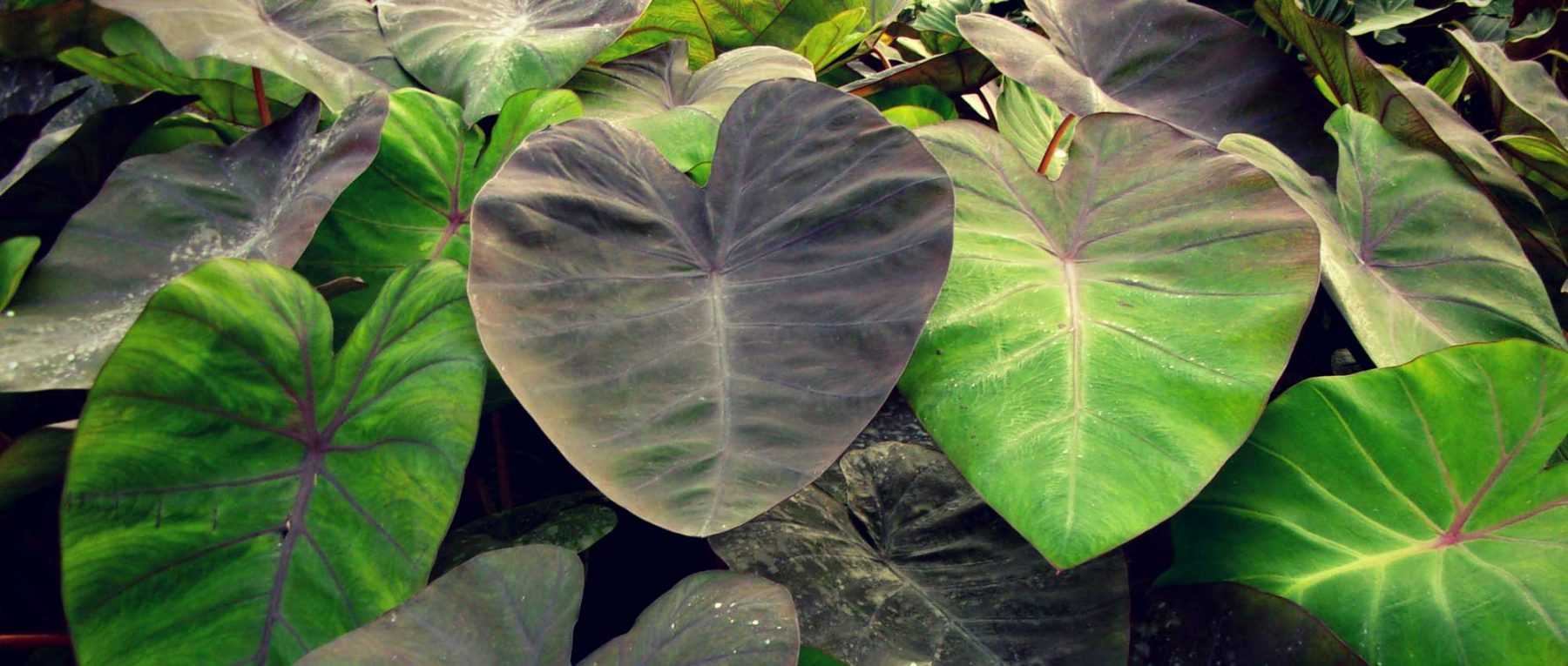
Colocasia: Planting, Growing and Caring for Your Young Plant
Contents
The colocasia in a few words
- The Colocasia boasts lush and spectacular foliage, often in beautiful hues
- It’s perfect for adding an exotic touch to gardens and terraces
- This is a robust and vigorous young plant that grows rapidly!
- Thriving in moist soil, it’s ideal for planting along pond edges
- It can be potted and grown indoors
- Although a tropical plant, some varieties are surprisingly hardy, tolerating temperatures as low as -15°C!
Our Expert's Word
Also known as Elephant Ear, Taro or Caribbean Cabbage, colocasia is an exotic plant that impresses with its broad and majestic foliage, often displaying stunning hues. Although in some parts of the world it is primarily cultivated for its edible tuber once cooked, in the garden we appreciate colocasias for the exotic and lush appearance they bring. Their leaves can be green, black, variegated, with often very prominent veins in a contrasting shade. Discover the colocasia ‘Black Magic’, with very dark foliage, ‘Pink China’, with pink petioles, or the Colocasia gigantea, which is exceptionally large! These plants add volume and quickly become a focal point in a flowerbed.
Colocasia is a robust and vigorous plant with rapid growth. It thrives in warmth and humidity and will do well on the banks of a pond or in another location where the soil is moist. Avoid letting the ground dry out! It can be planted directly in the garden or grown in a pot, allowing it to be brought indoors if needed during winter. It also adapts well to indoor cultivation or in a heated greenhouse! In terms of care, colocasia requires regular watering in summer, occasional fertilising, and possibly winter protection.
Botany
Botanical data
- Latin name Colocasia sp.
- Family Araceae
- Common name Colocasia, Taro, Elephant Ear, Caribbean Cabbage...
- Flowering infrequent
- Height between 70 cm and 2.50 m
- Exposure preferably partial shade
- Soil type moist, rich
- Hardiness variable. Quite tender, but some varieties can withstand temperatures down to -10 / -15°C.
The colocasia is a perennial herbaceous plant whose enormous leaves give it an exotic appearance. There are eight known species. The most common is Colocasia esculenta, or Taro, often cultivated for its edible tuber when cooked. Colocasia originates from the humid tropical regions of East Asia (Malaysia, Myanmar…). In the wild, it grows in damp meadows, on pond banks or along waterways… which explains why it thrives in moist soils and will flourish near a pond. Similarly, as they come from tropical regions, most colocasias are not very hardy… with the exception of a few varieties like ‘Pink China’ which can withstand temperatures as low as -15°C. Hybridisation has produced many varieties with original foliage, variegated, veined, and sometimes with coloured petioles.
Colocasia is classified among the Araceae, a family comprising over 3,000 plants native to tropical and subtropical zones… Including the most common houseplants: Monstera, Philodendron, Epipremnum aureum (Pothos), Dieffenbachia, Zamioculcas… Araceae often have very surprising flowers, like those of Amorphophallus, Arisaema or Dracunculus… These plants are also distinguished by their impressive foliage, very green but sometimes with beautiful hues. Colocasia closely resembles alocasia and xanthosoma, two genera to which it is very closely related, leading to some confusion.
Colocasia has many different common names: Taro, Elephant Ear, Caribbean Cabbage, Chinese Cabbage, Madeira… The name Elephant Ear is rather reserved for Alocasia macrorrhiza, alluding to the giant leaves, while Taro refers more specifically to Colocasia esculenta. In Latin, the species name, esculenta, means edible.
Colocasias are large plants measuring between 70 cm and 2.50 m… and even up to 3 m tall for Colocasia gigantea ‘Thailand Giant Strain’! There are a few smaller varieties, more suited to small gardens, like Colocasia ‘Madeira’, which doesn’t exceed 90 cm in height. Colocasias have very rapid growth, forming a clump of large leaves borne at the end of long petioles.
Colocasia mainly captivates us with its exceptional foliage, offering a beautiful diversity of shades! Its leaves come in a wide range of greens: from bright yellow-green to dark green, often slightly bluish. They can also be purplish, and sometimes almost black (‘Black Magic’)… The colours are magnificent in colocasia ‘Blue Hawai’; they take on rich shades of green, yellow and blue.
The veins, as well as the edge of the lamina, are usually very marked, with a different colour (often light green, brighter than the rest of the lamina), creating patterns, as in ‘Emerald’ or ‘Imperial Gigante’. Some varieties have a very surprising variegated effect, like Colocasia ‘Mojito’!
The leaves are heart-shaped (cordate), even slightly sagittate (arrow-shaped). They are quite thick, leathery, and measure between 60-80 cm long by 50-60 cm wide… But reach up to 1.50 m in length in the largest varieties. The edge of the lamina is slightly undulate. The leaves are sometimes slightly plicate, as in Colocasia gigantea or Colocasia ‘Black Stem’. They are inclined towards the ground, unlike alocasia which often have leaves pointing skywards.


Colocasia foliage! From left to right, varieties ‘Black Magic’, ‘Imperial Gigante’, ‘Mojito’ and ‘Pink China’
When water droplets fall on colocasia leaves, they bead up, not spreading but retaining a spherical shape, like on a lotus. They don’t adhere to the surface but slide off, taking dust and dirt with them. The foliar surface is said to be hydrophobic.
The leaves are attached to the clump by a long, thick petiole, measuring up to 1 m in length. It is sheathing, meaning it envelops the base of other petioles. It sometimes takes on superb colours! It is pink in the variety ‘Pink China’, and adorned with a beautiful black hue in the variety ‘Black Stem’, offering a lovely contrast with the lighter leaf.
The foliage is evergreen in warm climates, but deciduous when temperatures are cool (in this case, the aerial parts disappear but the plant remains underground, dormant, in the form of a tubercle). This therefore depends on your cultivation method, depending on whether you keep it outdoors, in a conservatory or in a heated greenhouse… The temperature must be at least 15 or 20°C for the foliage to persist in winter.
Colocasia has rootstocks (underground stems), which swell and form tubercles (storage organs), making propagation easier. The tubercles of taro, Colocasia esculenta, are edible when cooked. Colocasia also has the particularity of emitting stolons.


The flowering of Colocasia esculenta (photo Dinesh Valke) and the tubercles (photo Forest & Kim Starr)
It is quite rare for colocasia to flower when cultivated in our gardens. When one is lucky enough to see it, one can observe a flowering very characteristic of Araceae, appearing in summer, around August and September. The flowers are tiny and grouped on a spike (spadix), enveloped by a bract (spathe), exactly like in Arums. The female flowers are located at the base of the spike, and the male flowers on the upper part of it. The inflorescences have a pale cream-yellow hue and a horn-shaped form. They are situated in the axil of the leaves, between the petioles.
The fruits of colocasia are small berries that appear on the lower part of the floral spike, once it has faded.
The main varieties of colocasia
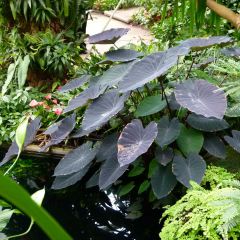
Colocasia esculenta Black magic
- Flowering time August, September
- Height at maturity 1,60 m
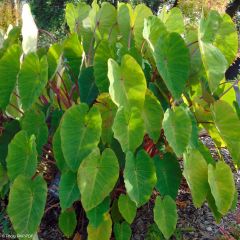
Colocasia Pink China
- Flowering time June to November
- Height at maturity 1,25 m

Colocasia Madeira
- Flowering time August, September
- Height at maturity 90 cm
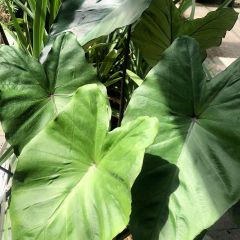
Colocasia esculenta Black Stem
- Flowering time July, August
- Height at maturity 1,80 m
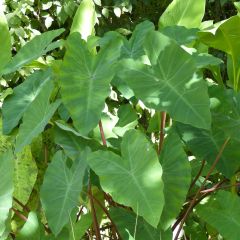
Colocasia esculenta - Elephant Ears
- Flowering time August, September
- Height at maturity 1,50 m
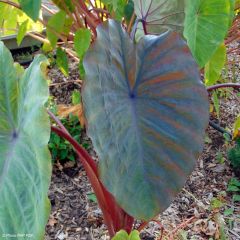
Colocasia esculenta Sangria
- Height at maturity 1,25 m
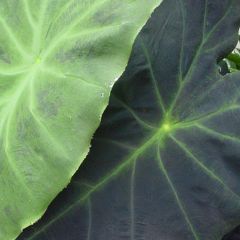
Colocasia Dragon Heart Gigantes - Elephants Ear
- Flowering time August, September
- Height at maturity 2 m
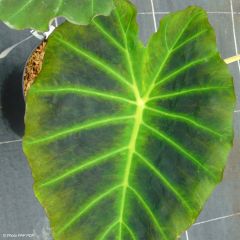
Colocasia Imperial Gigante - Elephants Ear
- Flowering time August, September
- Height at maturity 2 m
Discover other Colocasia
View all →Available in 2 sizes
Available in 2 sizes
Available in 2 sizes
Available in 1 sizes
Available in 2 sizes
Available in 1 sizes
Available in 1 sizes
Available in 2 sizes
Available in 2 sizes
Planting
Where to plant?
The ideal location for colocasia is under light shade. Avoid placing it in scorching sun; it will appreciate some shade during the hottest hours of the afternoon. We also recommend planting it in a spot sheltered from strong winds, which could damage the leaves.
Colocasia thrives in moist soil, or at least cool conditions. Don’t hesitate to plant hardy varieties along the edges of a pond.
The substrate should be rich in humus and fertile. You can add well-rotted compost to the substrate before planting, then apply fertiliser during cultivation.
Colocasia does not particularly like chalky soils, preferring a slightly acidic substrate (with a pH between 5.5 and 7).
As colocasia enjoys warmth and is not always very hardy (unless you choose a variety like ‘Pink China’), it can be grown in pots indoors, in an apartment, greenhouse, or conservatory, ideally at temperatures between 18 and 25°C. Place it in a bright spot but out of direct sunlight, which could scorch its foliage. The challenge with indoor cultivation is that the air can sometimes be too dry. It’s best to use a humidifier to increase air humidity.
Even if grown outdoors, keeping it in a pot allows you to bring it under cover in winter to protect it from the cold.
Colocasia is a large plant, so ensure there is enough space around it for proper growth. Keep in mind that it may cast some shade on nearby plants.
When to plant?
Colocasia is best planted in spring, after the last frosts, around April or May.
How to plant?
The sap of colocasia can irritate the skin, so it’s advisable to wear gloves when handling the plant.
- The plant may come in two forms: either potted or as a tubercle. If potted, place the root ball in a basin of water.
- Loosen the soil. Remove weeds, break up large clumps, and add well-rotted compost or leaf mould.
- Dig a planting hole.
- Plant the tubercle 5 to 10 cm deep. If your plant is potted, remove the root ball and place it in the planting hole.
- Backfill with soil and gently firm to ensure good contact between the substrate and the roots.
- Water thoroughly.
We recommend mulching around the base to retain soil moisture. Water regularly for the first few weeks while the plant establishes and develops its root system.
You can also plant your colocasia tubercle in a pot. Choose a large container and use a mix of garden soil, well-rotted compost, and potting compost.
→ Learn more in our guide: How to grow Alocasia or Colocasia indoors?
Maintenance
Colocasia needs moisture, ensure the substrate remains fresh. If the soil dries out for too long, the foliage may wilt. Don’t hesitate to water frequently during summer, preferably with non-calcareous water. Reduce watering (and fertiliser application) in winter.
Colocasia is a rather greedy plant: fertilise regularly during its growth. We recommend applying nitrogen-rich fertiliser every two to three weeks, especially if grown in a pot; this will help produce large, beautiful vegetation.
Also consider repotting your colocasia occasionally, ideally once a year, in late winter or early spring.
Overwintering:
There are various techniques to protect colocasia from cold in winter. It depends on your region and the hardiness of your variety.
If grown outdoors in the ground and it’s a relatively hardy variety, you can simply apply a thick layer of mulch at the base to protect it from the cold.
If you live in a cold region or your colocasia is not very hardy, you can also dig up the tubercles to store them indoors. Cut the leaves about 2 cm above the tubercle, then leave the tubercles exposed to air for at least a day to dry slightly. Store them in a dry place, in turf, sand or sawdust. The temperature should not drop below 7°C, ideally kept between 10 and 15°C. Check the tubercles occasionally. You can replant them in spring.
Alternatively, you can dig up the colocasia to temporarily pot it and bring it indoors for winter. You can then replant it in the ground in spring.
If growing your colocasia in a pot, simply bring it indoors to a conservatory, greenhouse or inside your home, at a temperature between 10 and 15°C in a bright location.
Diseases and pests:
Colocasia is a robust and vigorous plant, with few diseases and pests affecting it. However, you may encounter red spider mites, especially in dry air. Prevent this by maintaining good air humidity and misting the foliage. Sometimes thrips attack colocasia, small insects that pierce tissues to extract the plant’s sap. Slugs and snails may also consume the leaves (especially in spring).
In winter, the tubercle may rot, hence the importance of reducing watering during this period or storing tubercles in a dry place.
Propagation
Although it can be grown from seed, colocasia is primarily propagated by dividing the tubercles or by taking offsets produced by the stolons. This will allow you to regenerate your young plants.
Dividing the tubercles
Dividing helps prevent the clumps from becoming too dense while regenerating your young plants, and will allow you to relocate them to another spot in the garden. Colocasia sometimes produces small tubercles alongside the main one. Simply separate them. Carry out this process in late winter, around March.
- Carefully dig up the colocasia by loosening the soil around it if planted in the ground, or remove it from its pot.
- Remove some of the soil to expose the tubercles clearly. You can rinse them under water if needed.
- Divide by separating the tubercles.
- Replant them in pots filled with compost and water.
Layering of stolons
Like strawberries, colocasia sometimes produces long stolons that spread across the surface of the soil. These are horizontal stems that give rise to new clumps. You can easily detach them from the parent plant and then replant the young shoots in pots or a new location.
If you notice these horizontal stems, cover them lightly with soil to encourage rooting and the development of a new seedling. Once it has several leaves, you can separate it from the parent plant by cutting the connecting stolon. Replant in a pot and water.
Association
The best way to combine colocasia is to integrate it into an exotic garden, alongside other plants with lush foliage. Plant it for example with gunneras, arborescent ferns, banana trees, cordylines or phormiums… And possibly with a few palm trees! For flowers, choose plants that offer large, warm-toned blooms: canna, crocosmia, hedychium, watsonia or kniphofia… You can add arum lilies (Zantedeschia)… You’ll create a truly exotic garden!
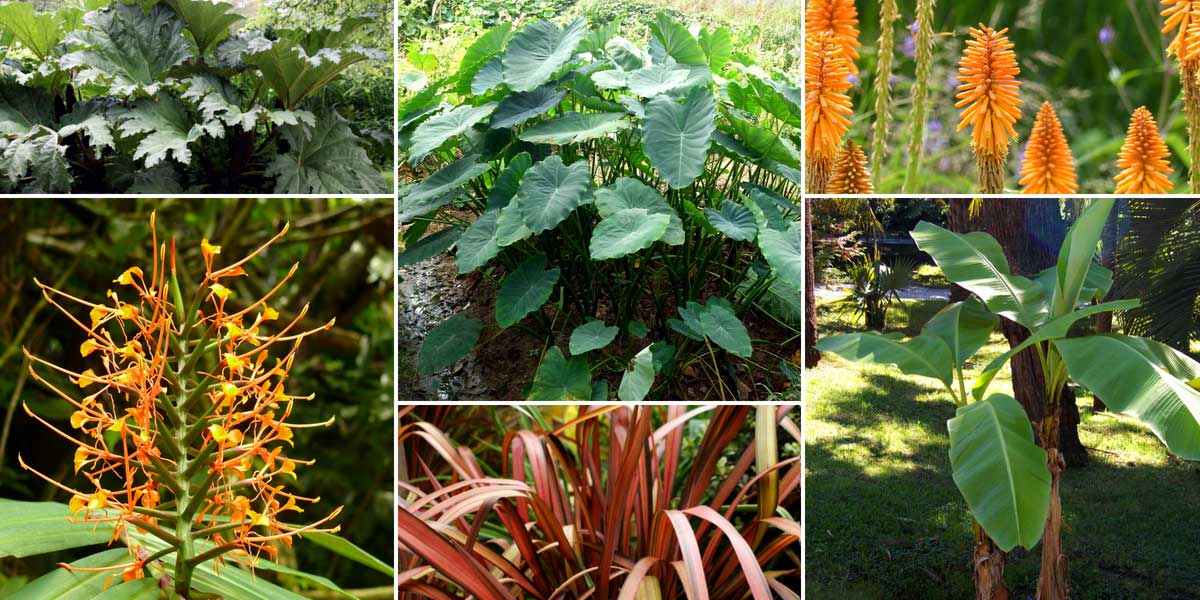

Colocasias are perfect in an exotic-style garden! Gunnera tinctoria (photo Drew Avery), Colocasia esculenta (photo Dalgial), Kniphofia ‘Fiery Fred’, Hedychium coccineum (Swati Sidhu), Phormium ‘Pink Panther’ and the banana tree Musa basjoo
As it’s a plant that enjoys coolness and moist soil, don’t hesitate to plant colocasia on pond edges, with gunneras, ferns, Iris pseudacorus or candelabra primroses… for a fresh and natural garden, ideal for relaxation!
You can also create a beautiful summer scene with warm tones, particularly with summer bulbs like dahlias, gladioli, freesias or lilies… generous and colourful blooms. Also enjoy the superb blue flowering of agapanthus!
Colocasias offer leaves in varied hues; you can therefore play with colours to create contrasts or special effects. For example, combine colocasias with almost black foliage (‘Black Magic’, ‘Dragon Heart Giant’…) with some plants in similar tones, like Sambucus ‘Black Lace’, Albizia ‘Summer Chocolate’, Cotinus coggygria ‘Royal Purple’, dahlias with dark foliage or the grass Pennisetum setaceum ‘Rubrum’… However, don’t overuse these tones, at the risk of creating a visually “heavy” border. The idea is rather to create contrasts. You can add bright, golden foliage, like that of Hakonechloa macra ‘Aureola’, Physocarpus ‘Dart’s Gold’ or Lysimachia nummularia ‘Aurea’.
Colocasia can find its place in a warm greenhouse, with other exotic or tropical plants. It’s also perfect in a patio, an inner courtyard, alongside ferns, hostas, bamboos or Fatsia japonica… for a modern and graphic garden!
→ Discover more association ideas with Colocasia in our advice sheet!
Did you know?
- Taro, an edible plant
Cultivated in Asia for several thousand years, taro, Colocasia esculenta, has edible tubers once cooked (but toxic when raw!), which is actually what gave it its species name, esculenta meaning edible. The tubers are particularly rich in starch and minerals (iron, calcium, vitamins…). They can sometimes be found in Asian grocery stores. The leaves can also be eaten after cooking. Precautions must be taken to cook it properly and avoid poisoning.
- Colocasia, Alocasia or Xanthosoma… What’s the difference?
These three botanical genera are very similar, to the point that they are often confused! In colocasias, the lamina of the leaf tends to point downwards, whereas it is generally upright in alocasias. Moreover, in alocasias and colocasias, it is heart-shaped, while in xanthosomas, it is sagittate, taking the shape of an arrow, with two rather pointed lobes at the base. Similarly, the petiole is connected to the leaf differently: in alocasia, it attaches to the edge of the lamina in a fairly ordinary way, so that the central vein is truly an extension of the lamina, holding the leaf upright. In colocasia, the petiole is attached to the underside of the leaf (peltate leaf), somewhat in the middle of the foliar surface, allowing it to angle and tilt towards the ground.
- Hydrophobic leaves
The foliar lamina of colocasias has the unique characteristic of being hydrophobic, like that of the lotus: water beads up and rolls off the leaf, without spreading! Thus, the foliage doesn’t really get wet. Water droplets maintain a spherical shape and flow away, taking dirt and dust with them…
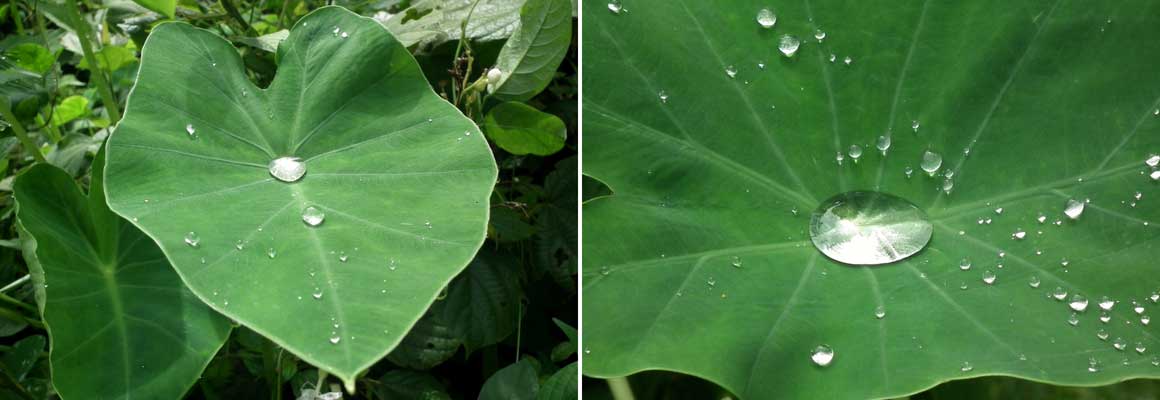

Water droplets slide off colocasia leaves without spreading, maintaining a spherical shape… (photo Rameshng)
Useful resources
- Discover our range of Colocasia!
- An article by Ingrid on our blog – 10 exotic and hardy plants for a Jungle garden
- For more ideas and inspiration – Exotic Ambience
- Subscribe!
- Contents



































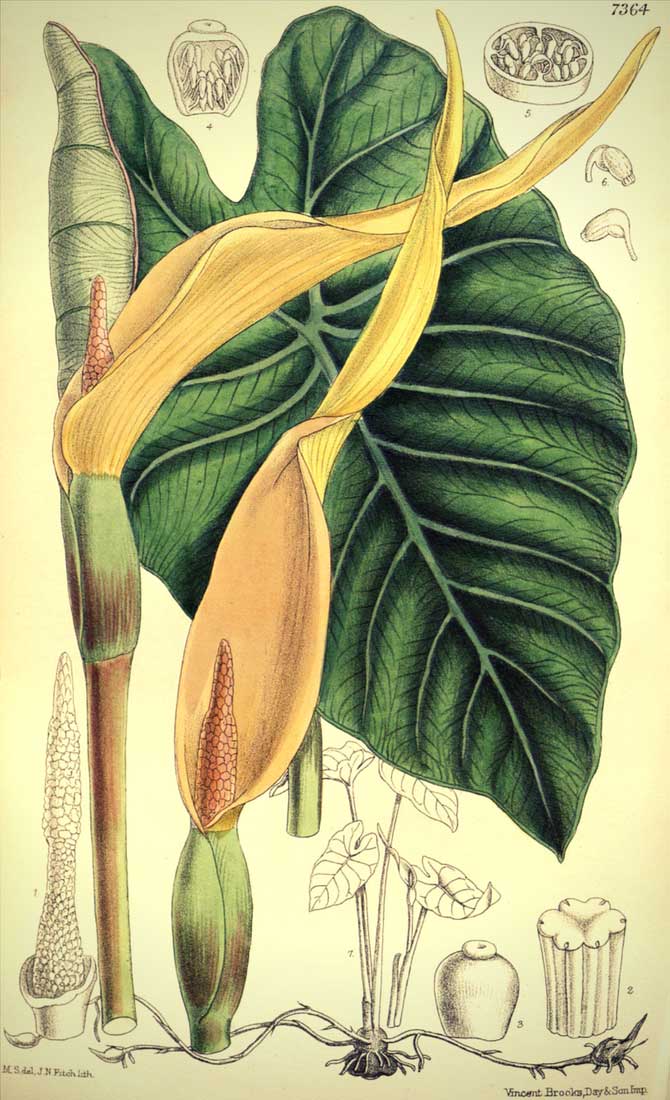
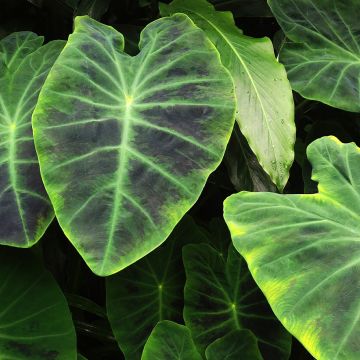

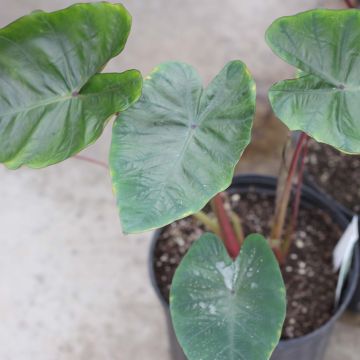
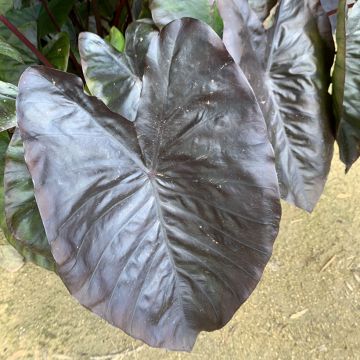
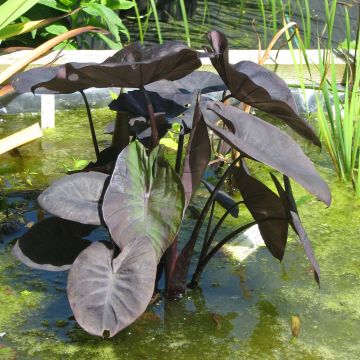

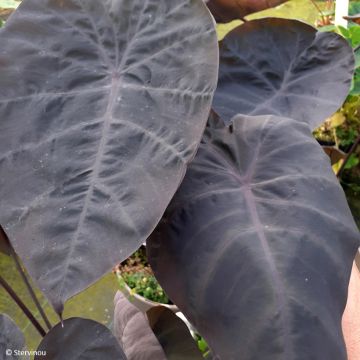


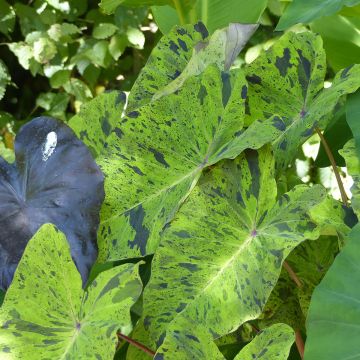
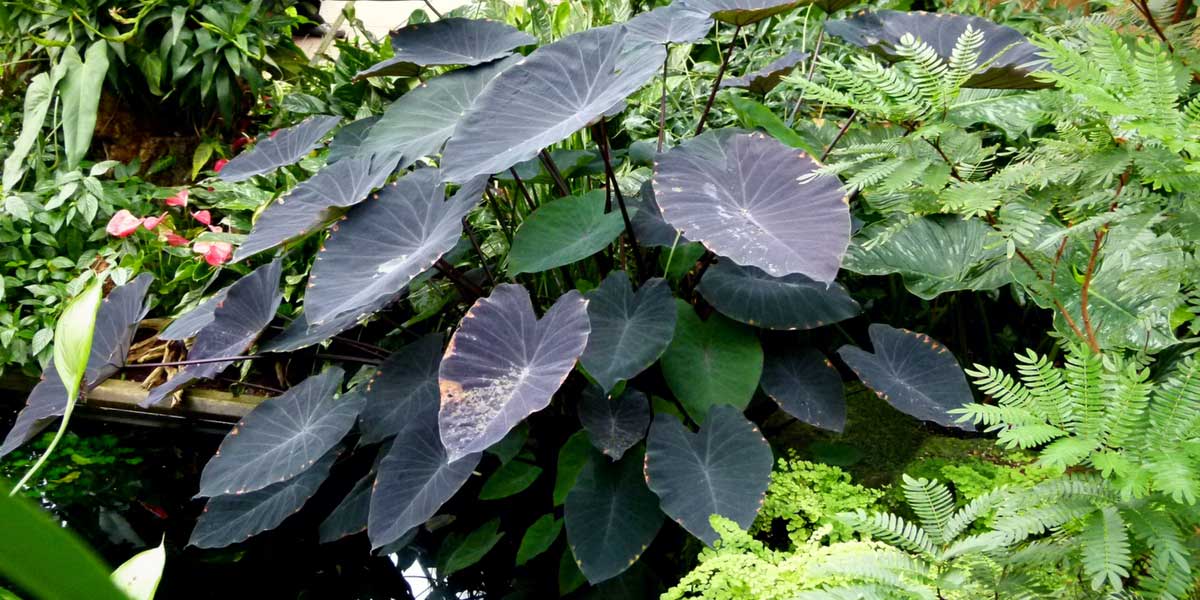
Comments